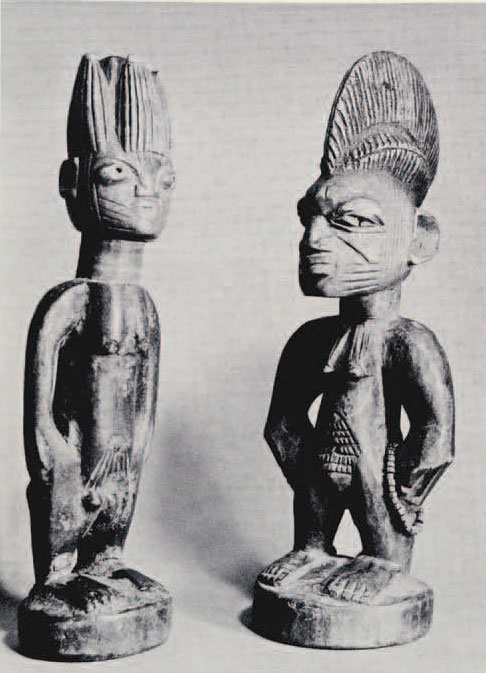
This poem translated from the Nigerian language group by Roger Wescott propounds a simple truth: it is a good thing to have children. Twins in particular have a religious significance. One of the cults of the Yoruba in Nigeria and Dahomey in West Africa is that of the ibeji (twins). The Yoruba differ from most West African tribes in welcoming the birth of twins and not considering them a moral calamity. Whenever one or both of the twins die, small twin figures such as the ones pictured here are carved in order to avert further visitations of death on the family. The figures are kept in family shrines and are ceremonially fed and anointed with oils on certain days to insure that the spirits of the dead twin or twins may remain with the tribe. These ceremonies are carried on sometimes as long as a hundred years after the death. The small figures are carved in accordance with the ancient traditions of the Yoruba and vary only in the individuality of the sculptor’s presentation.

The two small figures shown here are not an exact pair. They were collected in Nigeria in 1958 by William Fagg of The British Museum who presented them to The University Museum in memory of Webster Plass.
The stylized crown-like coiffure and the tubular treatment of the breasts suggest that the male was carved by Abogunde or one of his school in the early years of this century. Tribal striations on the face indicate the family tree of the twin represented. The power of this small sculpture–for it is only ten inches high–results from the plastic explosion of a columnar conception. Liberties have been taken in the proportion of the legs and the largeness of the feet, which grow out of the small disc of the base in the same way that the hands and thighs merge.
The female was purchased at Oyo but comes probably from Ogbomosho. Here the crested nature of the coiffure is recapitulated in the posing of the arms and in the general open-legged stance of the figure. The blue and red trade beads around the arm indicate membership in the Shango Society.
These small idealized portraits, albeit dolls. are great additions to the African collection of the Museum since we do not previously have this type represented. In their own right they stand as works of art, and in the greater sense, in the words of the poet, “What do you want a child for? Children make your life.”
